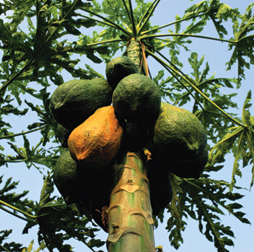The papaya plant carries the youngest Y chromosome ever found, reports a research team. That sex chromosome is so new evolutionarily that it doesn’t have the stripped-down style of full-fledged Y chromosomes.

The papaya chromosome carrying the gene for maleness doesn’t look different from the plant’s other chromosomes, explains Ray Ming of the Hawaii Agriculture Research Center in Aiea. Fine-scale genetic mapping indicates two traits characteristic of Y chromosomes, Ming and his colleagues report in the Jan. 22 Nature. The papaya’s male-determining region doesn’t swap genes with the corresponding region of its partner chromosome, and the Y region shows signs of genetic degeneration.
Deborah Charlesworth of the University of Edinburgh says, “It is not rash to call this a Y chromosome or at least an evolving Y.” The findings support the evolutionary theories of how sex chromosomes arise, she adds.
“As far as the Y chromosome’s evolution is involved, papaya obviously represents a very early step, probably the earliest studied now,” says plant–sex chromosome specialist Boris Vyskot of the Czech Academy of Sciences in Brno.
“Knowledge of sex determination in plants is negligible,” says Vyskot. Only about 5 percent of flowering plant species–including some familiar plants, such as hops, date palms, and spinach–form individuals with separate sexes. Papaya plants can turn out male, female, or hermaphroditic.
Not all plants with separate sexes have sex chromosomes that look different from their partner. Hemp does, for example, but willow trees don’t seem to, says Charlesworth.
For plants, separate sex chromosomes probably arose only some 20 million to
25 million years ago, says Ming. In contrast, the human Y chromosome dates from 200 million to 320 million years ago.
The general location of papaya’s male-determining gene was known before Ming’s team began its work. The researchers used genetic markers to make a detailed map of the area around that gene, although they haven’t yet sequenced the region’s DNA.
“They’ve done a lot of beautiful genetics,” Charlesworth says. “It’s a triumph to be able to get this amount of detail.”
In more than 2,000 papaya plants sampled, Ming and his colleagues found no evidence of gene swapping, or recombination, between the male-determining region and the comparable stretch on the partner chromosome.
Without recombination between chromosomes, Y chromosomes tend to degenerate. The papaya researchers report that this plant’s sex-determining region is starting to lose genes for nonsexual traits and to accumulate anomalous DNA. The region has only 62 percent of the gene density of the rest of the papaya chromosomes. It also shows 28 percent more rogue genetic elements and nearly triple the amount of DNA with a reversed orientation.
Vyskot welcomes studies of the papaya, with its conveniently small genome, but he says that other plants also hold promise for research on sex chromosome evolution. For example, some researchers are examining liverworts, which at one life stage have only a single set of chromosomes. Nevertheless, Vyskot says, “we can expect rapid progress in understanding the papaya genome, which is important both for basic research and plant breeding.”
****************
If you have a comment on this article that you would like considered for publication in Science News, send it to editors@sciencenews.org. Please include your name and location.







